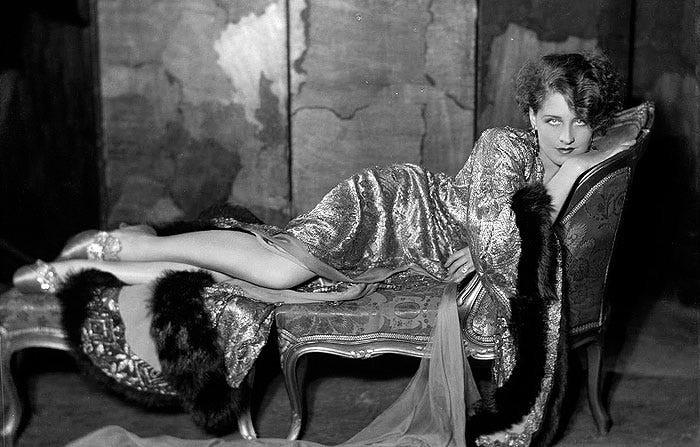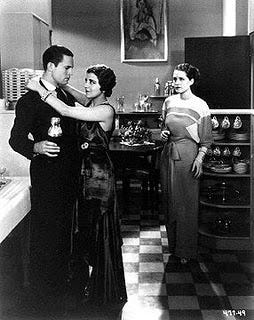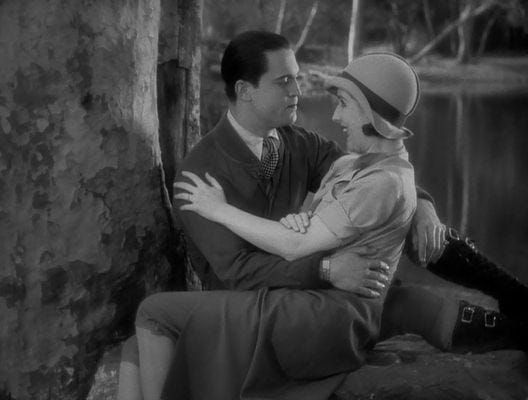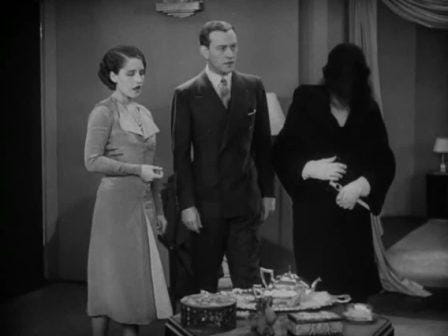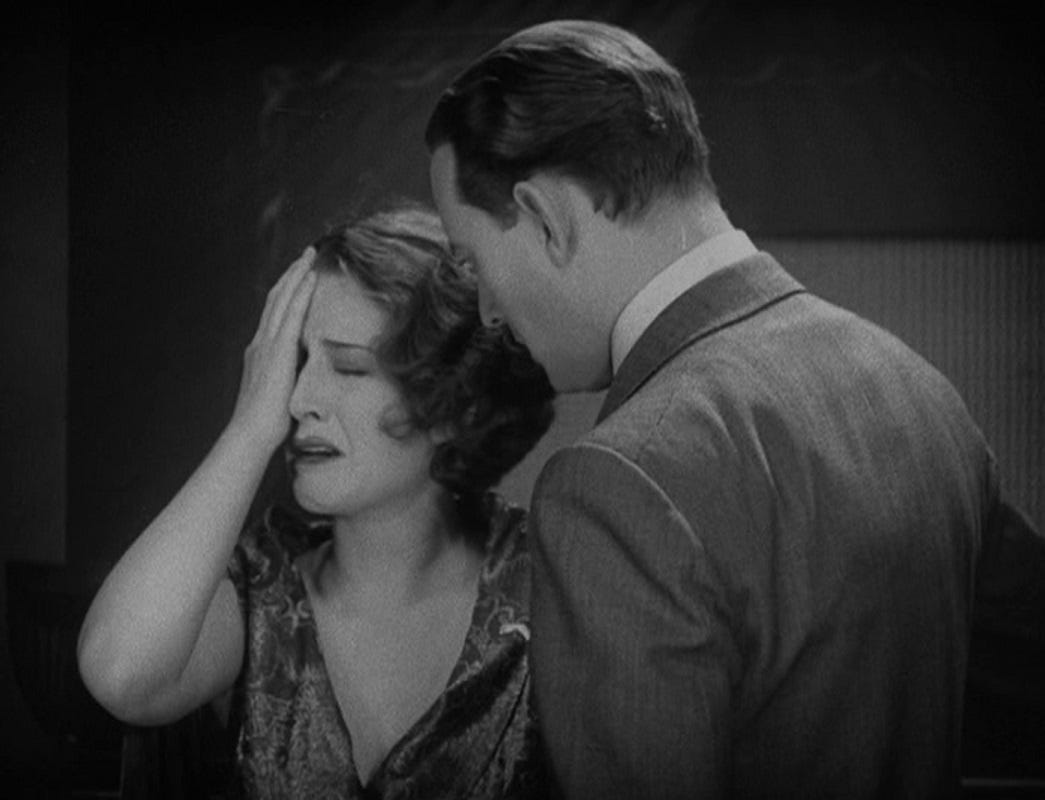The Divorcee (1930)
In 1929 the actress Norma Shearer, then under contract at MGM, learned that the studio had purchased the rights to Ursula Parrott’s recently published novel Ex-Wife, but that other stars were under consideration for the lead in the film adaptation, above all Joan Crawford. The studio thought Shearer had too pure an image to take on the role of a promiscuous divorcee.[1]
In fact, Shearer, with her slight squint, her face a little too long, her lips not full enough to really beckon, nevertheless had sex appeal, a kind that derived from a sense of approachability, a this-worldly beauty in contrast to the perpetual sizzle of Crawford or the divine remove of a Greta Garbo. And Shearer could sometimes sizzle onscreen too.
But Irving Thalberg didn’t think so. Thalberg was the head of MGM, and Shearer’s husband. The young studio executive and popular silent actress married in 1927 after Shearer converted to Judaism. Thalberg admired his wife’s abilities, but laughed at the notion of her playing Parrot’s character.
When Shearer came across the work of Los Angeles portrait photographer George Hurrell, she decided she had found her secret weapon. She had Hurrell capture her in a series of steamy lingerie photos, which she then showed to her husband as proof that she could do the part. The photos worked well: Thalberg hired Hurrell as MGM’s new head portrait photographer, enthusiastically put his wife in the movie role, and the couple were soon expecting their first child.[2]
Shearer hoped the movie would establish her as a top line star in the sound era. Thalberg was hoping for a big profit. The scandalous subject matter of Parrott’s book seemed to make both possible, but it also drew concerns about the negative moral influence of Hollywood movies that were culminating in the Hays Code.
Thalberg made sure to “push the film through the Hays Office before the new Production Code went into effect,” though he also tried to reassure potential detractors that the film recognized divorce as a social ill. Thalberg’s compromises with the Studio Relations Committee that oversaw Hollywood’s self-policing of content included a title change from Ex-Wife to The Divorcee and even leaving mention of Parrott’s novel out of all publicity.[3]
In fact, The Divorcee tells a rather different story from Ex-Wife. Made from a treatment by Zelda Sears, with a script by screenwriter John Meehan and writer-director Nick Grinde, The Divorcee yet shows traces of its origin in Parrott’s novel. Like Ex-Wife, the film depicts a marriage undone by tit-for-tat infidelities, follows its heroine through a string of casual affairs, and shows her briefly finding happiness with a married man whom she relinquishes when his wife shows up.
Yet the hard-drinking bohemianism of the novel’s Greenwich Village is exchanged for a more abstract high society world. The husband is jealous and prideful, but not physically abusive. His infidelity seems not to be a habit or part of any anti-bourgeois free love crusade, but is instead regretted almost as soon as it happens. Most notably, the film concludes with a reconciliation between ex-wife and ex-husband.
The Divorcee changes Patricia and Peter to Jerry and Ted. The movie begins with a bunch of jolly flapper types and their young men entertaining each other at Jerry’s father’s country lodge. Ted proposes marriage to Jerry, who accepts, to the sorrow of her friend Paul, who is in love with her—while this turn of events pleases their friend Dorothy, who is in love with Paul.
Notable is the inclusion of Jerry’s father. In the novel, Patricia’s father is a pale, Victorian presence, representative of a pre-war generation that could look on modernity optimistically because it was still solidly rooted in nineteenth-century morality. In the film, the father—the mother is absent and never referenced—seems to exist in order to show that his preferences regarding his daughter’s romantic choices are to be ignored. When he is told who Jerry will marry, he receives only a “hope you don’t mind” from Ted.
Jerry and Ted enjoy performing their happiness for their friends. Playing on the staircase in full view of everyone they loudly call each other “Romeo” and “Juliet.” (Shearer would play Juliet in the 1936 MGM film of the Shakespeare play.) Their loud affection feels stiff and unoriginal. This matches the film’s uninspired camerawork, but also presents the kind of love that is insecure and requires a public to view and approve it. Even when Jerry and Ted are seemingly alone by the river in the earlier proposal scene, we discover that there is a boy nearby overseeing their fishing rods, who impatiently tells Jerry to say yes to Ted so that he can go home.
Yet in the staircase scene there is foreshadowing of what may lie beneath the performance. Ted says to Jerry, “I can’t let you out of my sight a minute,” and she responds, “Soon you’ll be wondering how to get rid of me.” In retrospect, both lines are pointedly ambiguous.
Paul is established as roughly the counterpart to Noel in the novel when, after drinking to drown his sorrow over losing Jerry to Ted, he drives recklessly and crashes his car, leaving his passenger Dorothy disfigured. From the subsequent scene of Jerry and Ted’s wedding in a beautiful cathedral, we cut to Paul and Dorothy getting married in the hospital, a decision Paul makes out of guilt. Dorothy’s face is bandaged, and no one looks particularly happy.
Three years later, Jerry and Ted still seem superficially happy, but when a group of their friends show up at their apartment they have brought along the divorcee Janice, who has already had a secret dalliance with Ted. Janice wants more, cornering Ted in the kitchen, though he tells her he was “plastered” when they had their hook-up, and that he hasn’t spoken to her since because of “conscience.” This seems to establish Ted as flawed and rather less than self-aware, but not a serial philanderer. At this moment, however, Jerry enters the kitchen to see Janice with her arms around Ted.
I’m reminded of a passage in Darnton’s essay in which one of the octogenarians he interviewed recollected a bathtub gin party in the 1920s in which, like Jerry, she went into her kitchen to fetch something and found her husband kissing another woman. She tells Darnton what she told herself then: “I did not have to open that door. If it had remained closed, I would not have seen anything. I will not let that door determine the course of my life. I did not open it. It didn’t happen.” Darnton writes: “I thought that I could see through her thin body to the inner wound, still unhealed, a half century later.”[4]
Jerry does not choose to pretend the door stayed closed. She confronts Ted, who wants her to shrug it off. “It doesn’t mean a thing” he says, and challenges Jerry: “Was that a lot of talk about a man’s point of view?”
This is a reference to the proposal scene. In that early scene, Ted tells Jerry he will only marry her when he has saved enough money. She laughingly chides him, asking why she should wait for him while he’ll be sowing his wild oats in the meanwhile. “You’re just human,” she tells him. “So am I.” She has the same sexual needs he does, and wants them to get married so they can get to it.
Ted is impressed with her honesty about such things. “You’ve got a man’s point of view,” he says. From this, Jerry makes what we will see later is a questionable leap, unshared by Ted. She responds: “That’s why we’re going to make a go of it.” Equality and openness will be their values, she proclaims: “Everything equal.”
This is the central concern of the film: what the implications of—and even possibilities for—such equality are, and what it means for a woman to have “a man’s point of view” about sex.
Ex-Wife was grim and tragic on the matter. The novel showed it is possible for a woman to disengage sex from emotion in the way that men often do, but the result is unhappy. For women, sexual equality entails freedom but also painful loss. The Divorcee, more uncertain, nevertheless seems to come to the same conclusion.
Jerry makes reference to Ted’s comment after he leaves that night on a business trip to Chicago. Returning from a party, Ted’s friend Don asks the downcast Jerry what’s wrong. She says: “I’m just trying to hang on to the marvelous latitude of a man’s point of view.” But she doesn’t appear to accept the idea that infidelity “doesn’t mean a thing,” as Ted insisted, let alone that she might also stray from the marriage without it meaning anything. That starts to change when she finds Janice’s cigarette case in their apartment. She rushes out of the apartment again with Don, determined to seek that “marvelous latitude.”
The next scene finds Jerry with the affably intoxicated Don at a nightclub. We watch Shearer’s face shift from depression to determination and, as she and Don ride in a taxi back to his place, her lips and eyes tauten ever so slightly into the devilish smirk of a woman about to carry out a mission. When Ted returns from his trip, mildly contrite and hopeful that she has forgiven him, she tells him: “I’ve balanced our accounts.”
Ted unravels at this, making a drunken scene at the wedding reception of their friends. Later, he packs to leave Jerry who tries to convince him to stay. He appeals to his male pride, but Jerry insists on the equality she thought would be the basis of their marriage. “Don’t let’s talk about men and women,” she tells Ted. “They do all sorts of things. We’ve got to live our own life, dear.”
Ted complains that he is unable to endure the knowledge that he lives in the same world with some unknown man—“or men,” he says; like Patricia in Ex-Wife, Jerry refuses to divulge that her lover is her husband’s best friend—who has slept with his wife. Now Jerry is really angry. Since she was a virgin and Ted was not when they married, she had accepted that there are women who have slept with her husband. She loves him and wants forgiveness on the basis of an equality that, we recall, Ted had never explicitly affirmed. She finds herself rebuffed by the double standard of his “man’s pride.”
Rather than give in to this double standard she will challenge it directly, in the bedroom. “From now on,” she defiantly tells Ted, “you’re the only man in the world that my door is closed to!”
This is the scene that film critic Mick LaSalle, in his book Complicated Women: Sex and Power in Pre-Code Hollywood, finds inspiring, a leap forward for women’s empowerment and gender equality. Shearer, he writes,
made Jerry sympathetic by playing her as an intelligent woman on a sincere journey of self-discovery. She was the new woman, finding a way toward her own truth in a new world of skyscrapers, honking horns, and jazz.
It was high time this new woman showed her face on screen. In making The Divorcee, Hollywood was finally catching up with facts that the censors would eventually force it to deny. Women had changed. So had marriage.[5]
LaSalle takes this sunny view because he assumes from the start of his book that the twentieth century’s liberation of women and men from Victorian social arrangements is uncomplicatedly wonderful, a righteous march forward toward ever greater happiness and authenticity. But in order to adhere to this now rather conventional account he has to ignore crucial scenes in the movie that defy such easy narratives, scenes that return us to the pained ambivalence of Parrott’s novel.[6]
For instance, LaSalle writes that Jerry “all but forgets her husband the second he is out the door.” In fact, she never really gets over him. We briefly see her in a courtroom having been granted a divorce. Jerry’s friend Helen congratulates her, saying that now “all men are fair game,” to which Jerry responds that there’s only one man she truly wants.
When Jerry next sees Ted at a New Year’s Eve party, she pursues him, but he is still too consumed with ego and jealousy and storms off. And at the film’s end she and Ted are reunited.
Jerry was going to marry her old friend Paul, in love with her and getting a divorce from the disfigured Dorothy. But Dorothy shows up, her face hidden behind a black veil, and says that she has changed her mind about agreeing to a divorce. Dorothy confesses to Paul that she has no pride in what she is doing. “Maybe our marriage hasn’t meant much,” she tells him. “But there’s nothing at all without it. It has given me an excuse for living, being married to you. There isn’t anything else.”
Hearing this, Jerry is moved, not to pity but to admiration. Dorothy, she says, is “trying to hang on” to her marriage whereas “I quit.” Resolved to fight once again for her marriage, she ends her relationship with Paul and goes to look for Ted.
Ted is in Paris, drinking to try to forget Jerry. When Jerry finds him he is finally humble, decent, and self-reflective. He has heard that Jerry is marrying Paul and he wishes her happiness, saying: “I hope that other fellow gives you the break you deserve. I certainly didn’t.” She responds telling him she has been looking all over Paris for him, and that she has no other husband but him. He asks for another chance, and they kiss.
Of course such a contrived conclusion was almost certainly a studio requirement, providing a happy ending that would ensure customer satisfaction at the box office, and allay the concerns of moral critics that the movie might glorify divorce. Reunions of divorced couples had long been a common plot device, especially in the genre known as the “comedy of remarriage,” allowing filmmakers to explore erotic complexity and marital crisis while preserving the semblance of commitment to the institutions of marriage and monogamy.
Yet it is not only the ending that makes The Divorcee closer to Ex-Wife than to LaSalle’s description of a positive “journey of self-discovery” by a “new woman.” It is precisely the film’s depiction of the sexual freedom Jerry enjoys after her divorce, and its psychic consequences, that is more equivocal than LaSalle allows.
Rather than the detailed tell-all of Parrott’s book we get a relatively brief montage of Jerry and her new lovers, composed of close-ups of her hands and gifts of jewelry where once only a wedding ring had been. This breaks into a new scene of Jerry on a train in a private car with her latest suitor, a foreigner named Ivan. Jerry is far too jaded now to be impressed with Ivan’s come-ons, which she derides as nothing more than a “gorilla calling to its mate.” Increasingly possessive, Ivan would likely be the counterpart to the rapist Stepan in Ex-Wife, were it not for the kindly Paul showing up on the same train and sending Ivan packing.
And here we get a key scene that probes the emotional cost of the sexual tear Jerry has been on. She is all smiles and sarcasm when Paul arrives. He tells her he has heard about her adventures, but does not intend to be at all judgmental. And that is when Jerry breaks down sobbing. “I’m so tired,” she says. “I’m so tired.” It seems her bon vivant exterior has been something of a performance, just as her youthful clowning as “Juliet” to Ted’s “Romeo” was.
Sex without love, without commitment, but only as another “gorilla calling to its mate,” has left her emotionally exhausted. “I’m so tired” is in fact Patricia’s refrain in the novel Ex-Wife as she chronicles the emptiness of her one-night stands. When Paul finds Jerry, she is broken and needs to recover. Paul lets her sleep, shuts the door to her compartment—the door that was supposed to be open to all men save her ex-husband—and tells the porter not to let anyone in.
So is The Divorcee a case for gender equality? Jerry stands up for herself, insisting on fairness and mutual respect from her husband, insists on the equality she spoke of when he proposed to her. When Ted betrays her, she helps herself to the same dish, and when he insists that she defer to his feelings as an injured male, she insists on her rights as a sexual equal and autonomous person. And the odyssey that intervenes between their divorce and their reunion seems to have tempered Ted’s ego, making him more compassionate and more vulnerable.
Yet as we have seen, the film also borrows from Ex-Wife’s hard-bitten weariness attending, if not specifically female promiscuity, then at least the general experience of sex untethered from any meaning apart from will and self-assertion. We may question what Jerry has gained from “trying to hang on to the marvelous latitude of a man’s point of view.”
What Norma Shearer gained from the role was the award for Best Actress at the third Academy Awards, establishing her in the top tier of Hollywood talent. The Divorcee was also nominated for best director (the dependable Robert Z. Leonard), best writing (John Meehan’s script based on Parrott’s book), and outstanding production. Seven more films based on works by Ursula Parrott would follow, featuring such actors as James Stewart, Humphrey Bogart, and Cary Grant. But The Divorcee was the first, and it established divorce as a subject for film in the sound era, showing that the subject could be treated without easy censoriousness, while still registering its painful toll.[7]
Sources:
Darnton, Robert. “The Old-Girl Network.” Raritan 31, 1 (Summer 2011): 156-78.
LaSalle, Mick. Complicated Women: Sex and Power in Pre-Code Hollywood. New York: Thomas Dunne Books, 2000.
Vieira, Mark A. Irving Thalberg: Boy Wonder to Producer Prince. University of California Press, 2010.
[1] The rivalry between Shearer and Crawford began in the silent era. In the 1925 silent Lady of the Night, Shearer played two parts, an innocent daughter of the upper class, and a tough and sexy girl of the street. Crawford was the body double whenever both characters had to appear on screen together. On the decision to cast Shearer in the role, see Vieira 2010, 108-110.
[2] Vieira 2010, 109-110.
[3] Vieira 2010, 125.
[4] Darnton 2011, 168.
[5] LaSalle 2000, 68-69.
[6] “Before the [Hays] Code, women on screen took lovers, had babies out of wedlock, got rid of cheating husbands, enjoyed their sexuality, held down professional positions without apologizing for their self-sufficiency, and in general acted the way many of us think women acted only after 1968. They had fun. That’s why the Code came in. Yes, to a large degree, the Code came in to prevent women from having fun.” (LaSalle 2000, 1).
[7] The success of The Divorcee was followed by Let Us Be Gay (1930), a farce that also showed Shearer as the divorced woman free to compete sexually with her ex-husband after he cheats on her. “Like you, I’ve been amusing myself with anything and everything that came my way,” she tells him three years on. “I know how a man feels about those things now.” Shearer begins the film as loving and dutiful wife—and without make-up, an extraordinary decision for the Hollywood star, and one that makes her post-marital transformation into cynical vamp more striking. But this less consequential follow-up to The Divorcee defers any reckoning with the darker themes of the earlier movie until the last five seconds when Shearer improbably collapses into the arms of her unimpressive ex-husband. This film also shows us the couple’s two young children, who are used as a weapon to keep the ex-husband from remarrying.





